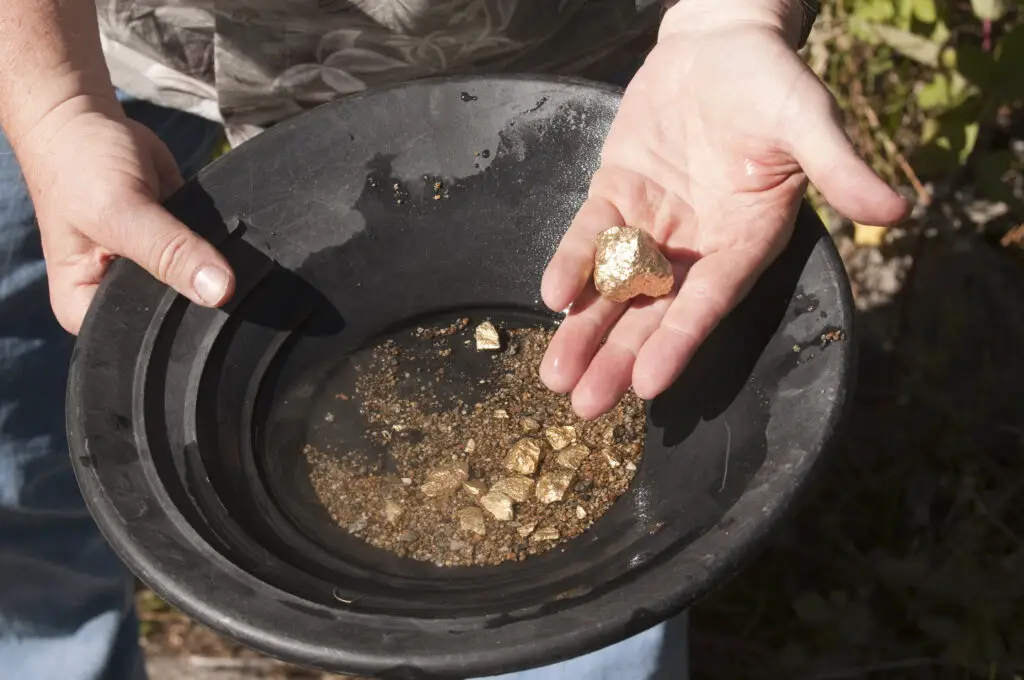Prospecting in California has been done for decades, and this can be from professionals to people wanting a fun day out. Like all countries and states though there are always rules put in place by the government on what you can and can’t do.
What is Allowed Regarding Prospecting in California?
It definitely is legal to prospect in California. It is advised to check in each county or territory you are in as each place is different, and this goes for gold panning and sluicing too.
This is the short answer! Throughout this article we are going to discuss Where exactly it is legal to prospect and this includes gold panning. We also have a section on highbanking and sluicing. Hope this helps you out so you can go and find some Gold.

Is Prospecting Allowed And Legal In California?
The short answer is yes. When you are considering trying your luck in prospecting for gold in California, this activity is legal.
Still, you need to check first with the legal authority because these activities are all subject to county, federal, state laws or regulations to be given the green light to proceed.
Keyesville Mining District is the first area where gold was discovered (back in the day), and the activity is going until present times. You can prospect anywhere in the region where you can mine gold.
A significant percentage of lands where you can prospect gold is looked after by the BLM which stands for Bureau of Land Management and the USFS.
Still, they are open for a prospective person for mineral exploration. This means that whenever you want to go and try your luck, you can go and look for gold, minerals, and gems. These include panning, sluicing, and using the essential tool for exploration.
Many of these rich mineral states managed by BLM and USFS are public lands. They are found in Nevada, Arizona, and Idaho, and they have many open grounds where anybody interested in prospecting can go.
A general rule applies to any prospective person who wants to carry out gold mining in public lands in California. One must meet mining laws formed since the gold rush began in this region, and some of them apply to date. They include:
(I)Archeological and Historical Sites: These areas include ground sluicing places, hydraulic pits, hard rock mines that were once active. The General Mining Law of 1872 gives people the right to go and look for gold in these areas.
(II)Active Mining Claims: The other important consideration that one must consider is the area with active mining claims. Most of these areas are publicly owned lands with gold and other minerals, and most of them have claims.
Therefore, when you don’t have permission, you cannot contact any gold mining activity in these parcels of land. You can only react to them by camping, fishing, and hunting, not extracting gold.
Is Gold Panning Allowed In California?
Yes, gold panning is legal and allowed in California.
Most rivers and streams that cut across the state and national parks are prospective places to look, but your luck could be increased when you head to the regions where gold has previously been discovered in the recent past.
The state area being California state was the first place where the gold discovery took place in the mid-1800s. From early discovery brought the rapid growth of gold search. A lot of migration has happened from all over the world of people coming to explore gold in California.
Recreational gold panning around California is well organized and regulated. Most of the public lands in the region are looked after by (BLM). When you want to explore gold in the region, Mother Lode Field Office doors are wide open where you can file your mining claim under the 1872 Mining Act.
It is indicated that under this law that a person who makes a claim has the lawful right to gold or any other minerals found at the time. Presently, about 5,000 mining claims have processed on public areas.
Suppose you are a new mining entry in California and want to put a claim through in that spot. It would be best to get in touch with the BLM State Office straight away (they are located in Sacramento). From there, you will find out if a piece of land is already claimed or not.
Before laying your mining equipment on the ground, you need to submit your notice at BLM offices about your claim. It is worth noting that a mining claim doesn’t have to be submitted when one intends to live on public land.
It would help to familiarize yourself with the laws regarding gold mining in the region. The State of California passed SB 670, which forbids gold minors from using vacuum or other dredging equipment to perform in-stream mining activities on the lakes, rivers, and streams that flow around California, which took effect from August 6, 2009.
This moratorium prohibiting the use of specific equipment for mining will stay for the time being until the moment the Department of Fish and Game, which is reviewing the current dredging permitting program, completes an environmental analysis and revise its regulations.
No new permits will be issued to new recreational permit application individuals until the reviews for suction dredging are lifted. You can log into the BLM websites to learn more about the same.
No permit is needed for individuals or companies planning to conduct low-impact gold panning. Places where you can try your luck if you include:
(I)Northern California:
This region is believed to have the wealthiest spots to contact gold panning.
A place to try your luck in the region is like Marshal Gold Discovery State Historical Park, where you can pan at Auburn State Recreation Area, along the American River, north of Sacramento.
All permanent streambeds in the area are hotbeds to try your luck in finding gold.
Malakoff Diggings State Park is another area to explore where you can pan along 25 mileages in the river that cut across. Gold pan around Tahoe National Forest is also worth trying.
(II)Central California:
This region area worth trying include Millerton Lake State Recreational Area, the San Joaquin River Gorge, North of Fresno, northeast of the Fresno area.
(III)Southern Inland California:
The park areas in this region are good spots to try your luck though your options will be limited. You can try Red Rock Canyon State Park, streams in the area, east of Bakersfield, toward the Mojave Desert.
(IV)San Diego Area:
Panning for gold in this region can occur at the Julian Mining Company.
When you visit this place, you will be shown a demonstration and be allocated an hour to the pan. You need to go with a group of about 25 others, but smaller groups can also be allowed.
Is High Banking Or Sluicing Legal In California?
Local authorities highly control high banking or sluicing in California. Before you contact such activities, you need to visit the California State Water Resources Control Board offices to explain what you will do.
You will be granted the necessary permit. This activity has been going on in the region for decades, and it involves the processing of gold-bearing materials in a power sluice or a high banker.
The Fish and Game Code, California Water Code, and the Clean Water Act are some of the regulations used for checks and balances. These codes prohibit an individual from discharging water and waste sediment when using a high banker or power sluice within an area.
They may flow into the region’s rivers, lakes, streams, or other water bodies without acquiring a Regional Water Quality Control Board permit.
In high banking and power sluicing activities, water is pumped short distances from a waterway place. The pumped water in them is allowed to seep into open ground or evaporate so that it does not return to the river, stream, or creek.
Before you are issued a permit to carry out high banking and power sluicing in the California region, you have to file a report about how you will discharge your waste to the Regional Water Board for approval.
The board will then access your report to ascertain whether your planned activities will create or threaten the environment by forming pollution and nuisance in the region.
will remain in place until the time the Department of Fish and Game, which is reviewing the current dredging permitting program, completes an environmental analysis and revise its regulations.
No new permits will be issued to new recreational permit application individuals until the reviews for suction dredging are lifted. You can log into the BLM websites to learn more about the same.
No permit is needed for individuals or companies planning to conduct low-impact gold panning. Places where you can try your luck if you include:
(I)Northern California: This region is believed to have the wealthiest spots to contact gold panning. A place to try your luck in the region is like Marshal Gold Discovery State Historical Park, where you can pan at Auburn State Recreation Area, along the American River, north of Sacramento.
All permanent streambeds in the area are hotbeds to try your luck in finding gold.
Malakoff Diggings State Park is another area to explore where you can pan along 25 mileages in the river that cut across. Gold pan around Tahoe National Forest is also worth trying.
(II)Central California: This region area worth trying include Millerton Lake State Recreational Area, the San Joaquin River Gorge, North of Fresno, northeast of the Fresno area.
(III)Southern Inland California: The park areas in this region are good spots to try your luck though your options will be limited. You can try Red Rock Canyon State Park, streams in the area, east of Bakersfield, toward the Mojave Desert.
(IV)San Diego Area: Panning for gold in this region can occur at the Julian Mining Company. When you visit this place, you will be shown a demonstration and be allocated an hour to the pan.
You need to go with a group of about 25 others, but smaller groups can also be allowed.
Is Dredging Allowed In California?
Suction dredging has impacted the environment in many ways. This has made the state form strict laws to control such activities in the region. With state law in full effect, it is unlawful to be found using vacuum or suction dredge equipment in California’s water bodies, such as rivers, lakes, and streams.
If you are planning any activity related to dredging, it will be subject to enforcement and prosecution as a criminal offense. The Environmental Protection Agency in the State and State Water Boards are implementing these bans because these activities have caused significant impacts on water quality in the region and wildlife from pollution coming from mercury.
Environmentalists in the region believe these dredging activities to harvest gold risk destroying fish in the region’s water bodies and stirring up toxic mercury. But the activity has been legal for many years; it was only banned in 2009

